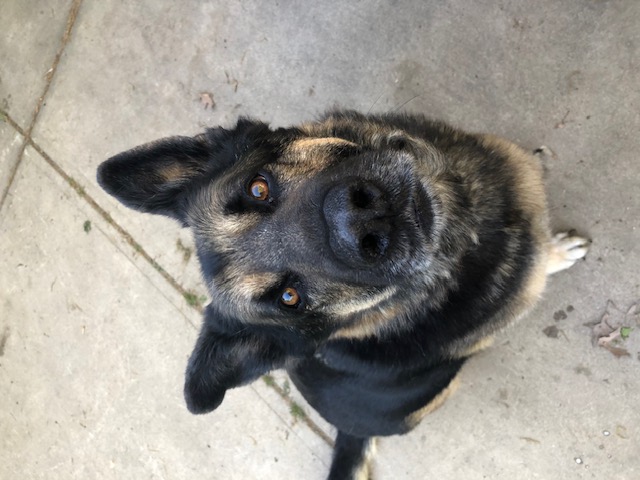Read our blog on osteoarthritis!
 Osteoarthritis commonly referred to as OA or arthritis is a degenerative joint disease present in dogs. Dog's who are older, overweight, those with genetic predispositions, as well as those with previous injuries have a higher prevalence of this disease. Arthritis in dogs can be really painful, it is characterized as the gradual degradation of the joint cartilage which leads to pain, inflammation, reduced activity, and reduced agility. Over time the reduced use of a limb can lead to muscle atrophy which is the wasting or thinning of muscle. This makes it that much harder for your dog to move around reducing their quality of life.
Osteoarthritis commonly referred to as OA or arthritis is a degenerative joint disease present in dogs. Dog's who are older, overweight, those with genetic predispositions, as well as those with previous injuries have a higher prevalence of this disease. Arthritis in dogs can be really painful, it is characterized as the gradual degradation of the joint cartilage which leads to pain, inflammation, reduced activity, and reduced agility. Over time the reduced use of a limb can lead to muscle atrophy which is the wasting or thinning of muscle. This makes it that much harder for your dog to move around reducing their quality of life.
Some symptoms dog owners may see showing your dog is in pain includes stiffness when getting up, limping, lagging behind on walks, reluctance to jump, reluctance to engage in physical activity or play, trouble posturing for defecation or urination, and behavior changes.
The best time to intervene is early on. The more we can prevent damage caused by inflammation, the better your pet's outcome can be.
As a pet owner, looking for those subtle signs a dog is in pain will be important when preventing the progression of OA. Our dogs will not show us they are in pain in the same way as humans will show pain. Though they do not verbally tell us they are uncomfortable, a closer look at their body language can tell us a lot as well as how they move around, especially at home. Unfortunately, us seeing them as "just getting old" or "just slowing down" really means they are in silent pain.
 Keeping an eye out for these changes, even though they may seem small, as well as taking a proactive approach will most often lead to the best outcomes leading to pain relief for your dog. You may ask "what arthritis medicine for dogs is available?" Proactive management of OA includes pain medication, dog joint supplements, prescription joint diets, monoclonal antibody therapy, weight control, and physical therapy. Research has proven that taking what is called a "multimodal" approach provides the best results, meaning using different therapies together to get a better outcome compared to using only one alone.
Keeping an eye out for these changes, even though they may seem small, as well as taking a proactive approach will most often lead to the best outcomes leading to pain relief for your dog. You may ask "what arthritis medicine for dogs is available?" Proactive management of OA includes pain medication, dog joint supplements, prescription joint diets, monoclonal antibody therapy, weight control, and physical therapy. Research has proven that taking what is called a "multimodal" approach provides the best results, meaning using different therapies together to get a better outcome compared to using only one alone.
All of these services are available to our clients at our three locations.
Visit our Senior Pet Wellness Page
At Home Exercises to Prevent Dog Muscle Loss
We have a better option to help facilitate pain relief for dogs: Introducing Librela!
Librela is available to our patients at all three locations. Modern medicine is wonderful and when it can benefit our dogs and cats, it is even better. Librela for dogs is one of the many monoclonal antibody therapies available now. The great thing about these medications is that it is safe to give your pet regardless of them having underlying health issues. Those pets whose body's were not able to process traditional medications such as dog specific NSAIDs like Rimadyl now have an option to have pain relief. Depending on the dog, we have seen better results after starting Librela versus being on Rimadyl alone. We strive to have the best in veterinary care for our patients and are proud to offer this option for your dog.
"I would definitely recommend this to anyone. Three days after receiving the medication she started acting like she was four years ago!" -Richard T. regarding his 13 year old dog Maggie pictured to the right
We recommend that you commit to at least two doses of Librela when deciding to start this therapy. Some dogs have shown improvement in their mobility in less than a week and others it can take longer.
"Molly is doing well, I saw an improvement within 24 hours of her injection. 2-3 days after her receiving it, she was like a new dog. More spunky and playful. When she was in pain, she was more withdrawn and testy. Seems more comfortable and is able to jump on the couch and bed again. I would recommend this to anyone who has a pet with osteoarthritis" -Chase H. regarding his 8 year old pug mix Molly
